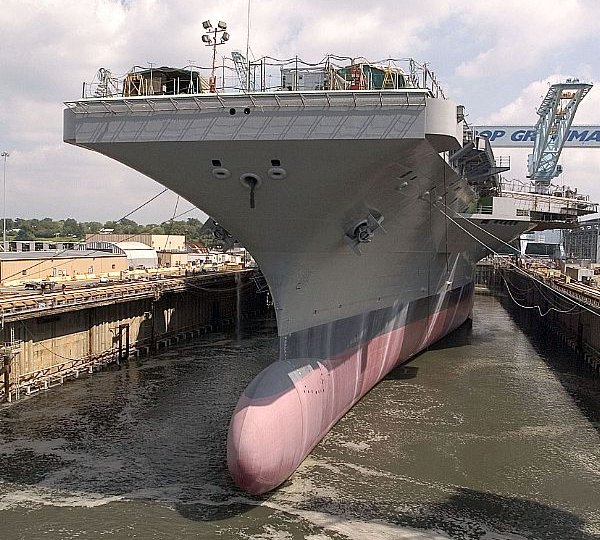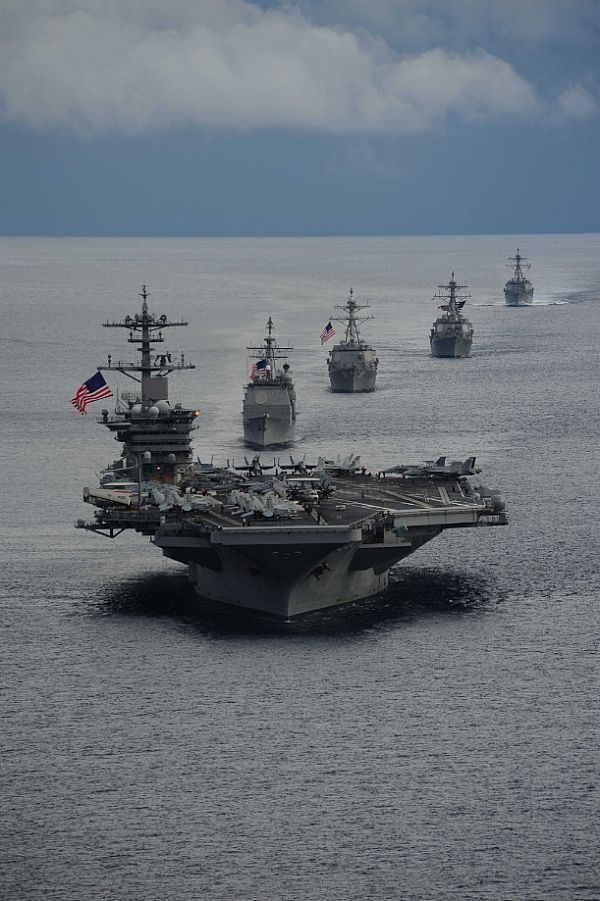A layman type of question from our senior members. Thing is a aircraft carrier group is a mini city having 4-5k crew at a time and i suppose all of them would be using electronic communication devices . When u put 5 thousand human biengs in middle of the sea with their electronic gadgets it would definitely possible to tract those radiations to trace a AC group. Is it possible or not?
How to install the app on iOS
Follow along with the video below to see how to install our site as a web app on your home screen.
Note: This feature may not be available in some browsers.
You are using an out of date browser. It may not display this or other websites correctly.
You should upgrade or use an alternative browser.
You should upgrade or use an alternative browser.
What It Would Really Take To Sink a modern Aircraft Carrier
- Thread starter monitor
- Start date
Comfortably Numb
FULL MEMBER

- Joined
- Nov 8, 2010
- Messages
- 216
- Reaction score
- 0
- Country
- Location
Iceberg?What It Would Really Take To Sink A Modern Aircraft Carrier
randomradio
BANNED

- Joined
- Feb 14, 2016
- Messages
- 6,974
- Reaction score
- -17
- Country
- Location
You do not have any answer.
Of course I don't. If I did I wouldn't be talking about it. I think this is the third time I'm telling you that.
When an attack aircraft flies over man made terrain, aka 'cities', this kind of clutter can -- not always -- create unanticipated interference that no radar can compensate for. So for you to say that clutter rejection is no longer an issue means you do not know what the hell you are talking about, especially when clutter rejection algorithm is STILL being taught.
This is what separate me from the rest on this forum in that I do not seek to discredit just because I do not like a specific country. If someone make a claim or post a source that is technically dubious, then I will challenge and I will support my arguments.
You are going to have to take that argument up with that Swedish pilot.
It was back in 2012 when an Israeli official said the F-35's stealth will be obsolete in 5-10 years. A British scientist said that when the Typhoon will get its AESA, the F-35 will be detectable on it over a very long range.
Are you calling them all liars? Especially when they are still working in the military or the industry while you've left the military a long time ago?
Of course clutter rejection algorithms will be taught, there are still many objects that are unnecessary for detection. When radars become thousands of times more accurate than your APG-68, even then you need clutter rejection. Radars are universal. You need them in trains, trucks, cars, ships etc. What's changed is the way clutter rejection happens in military radars because it now has to differentiate objects between clutter and target.
In your case, you are no different than many in that you just seek to discredit the US simply because you have some kind of animosity against US.
BS. I am not a Cold War relic. Whatever is good for the US is good for my country. I have no animosity against the US. I am just realistic with what to expect while trying to keep myself up-to-date about what's happening in this field. In fact, I'm in full support of most US policies. Hell, I've even supported the F-35 in my discussions with non-American professionals.
You will find me praising American systems, Chinese systems, Russian systems, Indian systems, European systems, even Pakistani systems when they deserve to be praised.
I am in awe of Chinese advancements in satellite technology, the same with American and Russian advancements in hypersonics. Also European advancement in stealth technology.
When it comes to military technology, I am not biased about one nation at all, not even about my own country. So your claim that I have an animosity against America is laughable.
A layman type of question from our senior members. Thing is a aircraft carrier group is a mini city having 4-5k crew at a time and i suppose all of them would be using electronic communication devices . When u put 5 thousand human biengs in middle of the sea with their electronic gadgets it would definitely possible to tract those radiations to trace a AC group. Is it possible or not?
Wouldn't the entire CBG be under EMCON (emissions control) protocol during any conflict or potential conflict?
http://www.navy.mil/submit/display.asp?story_id=75445
Thing is most of our communication devices are bieng assembled in china. And if China a keeps a track of the devices exported to US than if some of the ime numbers pop up in groups in middle of the ocean it will definitely give them a fair idea of the location of us navy ships. And ime numbers can be traced even if the devices are switched off.
C130
ELITE MEMBER

- Joined
- Aug 1, 2014
- Messages
- 8,092
- Reaction score
- -1
- Country
- Location
didn't get your tag for some reason.
There are only one way to sink an aircraft carrier. That is to break into the complex defence system that cover sea, air and information.
An aircraft carrier is protected in 4 tiers defences. The first tier is information.
Information is about threat detection and threat management, it may not be preform by the Carrier Group itself, it can be done by any of the ISTAR platform, ground radar, AWACS, maritime surveillance aircraft, naval surveillance ship, escorts and so on. The first battle is for the attacker to by-pass the detection, and the defender to sniff out attackers, both surface and sub-surface.
The second tier is the defence from the on broad air groups, they can reach out over the reach of the escort ship defences, and they can also detect and attack any threat present in the immediate area, each carrier carry about 50 F-18E/F and in between all those aircraft, they carry 200-400 AAM/ASM as a whole. Couple with AWACS like E-2D and other AWACS/AEWS platform, their job is to seek out the enemy before the enemy can enter the next phase.
The third tier is the defence form escort ship, a CBG would usually travel with 5-6 DDG and 1-2 CG, which mean at any time, the whole 220nm radius will be covered with 700 - 900 cell Mk41 VLS, which can be potential launching a mix of AAM like SM-2 and SM-6, ASM like Harpoon and BMD like SM-3 Travelling with a CBG would also include some Submarine and other assorted ship. Also with 5 inch gun, 3 inch gun and any sort of CWIS, Bushmaster and Machinegun.
When the threat can penetrate all that, then it will the forth tier, which is on broad ship defence. Which will be a mix of sea sparrow, RAM launcher, and CIWS.
That is what it take to sink a Carrier.
what about decoys and electronic warfare for the 4th tier or maybe say that's the 5th tier of defense

http://www.defenseindustrydaily.com/US-Navy-From-Slick-32s-to-SEWIP-05365/
jhungary
MILITARY PROFESSIONAL

- Joined
- Oct 24, 2012
- Messages
- 19,295
- Reaction score
- 387
- Country
- Location
what about decoys and electronic warfare for the 4th tier or maybe say that's the 5th tier of defense

http://www.defenseindustrydaily.com/US-Navy-From-Slick-32s-to-SEWIP-05365/
That's either 1st Tier (Information warfare) or 4th Tier (Ship's defence)
Thing is most of our communication devices are bieng assembled in china. And if China a keeps a track of the devices exported to US than if some of the ime numbers pop up in groups in middle of the ocean it will definitely give them a fair idea of the location of us navy ships. And ime numbers can be traced even if the devices are switched off.
3 problems.
1.)China sold heck a lot of device (either made in China, or assemble in China) It is quite hard to track all of them. How are you going to pick out a few thousand device from billions?
2.) Most sailor will not bring or cannot use Electronic device on board. Only senior member (CPO + Officers) are allow to use mobile device, even if there are reception (And most likely turn off and have battery removed during the voyage as there are no cell reception) You will not be tracking 4 to 5 K people, in fact, it would be a few hundred.
3.) Radar on board aircraft carrier would have produce more, a lot more, EM emission than a few hundred, if not thousand device, put together. it would be a lot easier to scan for Radar signal, which would be in kWs and MWs, rather than scanning for a concentrated burst of handheld device signal, which would only be in mWs
AZADPAKISTAN2009
ELITE MEMBER

- Joined
- Sep 8, 2009
- Messages
- 37,669
- Reaction score
- 68
- Country
- Location
ICE BERG

Start buying those Ice making machines


Start buying those Ice making machines

ICE BERG

Start buying those Ice making machines

Indeed, hopefully people will get it to sink the carriers in SCS!
Gomig-21
SENIOR MEMBER

- Joined
- Oct 16, 2016
- Messages
- 7,901
- Reaction score
- 11
- Country
- Location
Look at the way they design the hulls with their bulbous bows and a relatively narrow keel from that bulbous bow just to midship. The area below the waterline is about as minimal as can be for such a massive ship, it's quite impressive. Compare it to the deck's surface area and it's considerably smaller. Add in the overall height and and compare it to the height from the top of the black, water line on down and there is much more above water than below. And because of the ship's deadrise (the angle of the sides from edge of deck or chine if it has one which carriers don't) to keel is quite steep.

Not only are these hulls designed to withstand certain impacts, but look at how little of the hull and keel is actually under the water line. It would take full speed and careless captainship to not follow the state of the art navigation charts and hazard warnings they have at their disposal and make a major mistake and collide with an iceberg. Even if they find themselves in an area with icebergs, they'd proceed with extreme caution at very low speed or avoid that area completely and take the long way around.
With all the miles and miles of cruising that carriers have taken since their inception, I don't recall ever hearing of one being severely impacted by an iceberg. Could be wrong.

Not only are these hulls designed to withstand certain impacts, but look at how little of the hull and keel is actually under the water line. It would take full speed and careless captainship to not follow the state of the art navigation charts and hazard warnings they have at their disposal and make a major mistake and collide with an iceberg. Even if they find themselves in an area with icebergs, they'd proceed with extreme caution at very low speed or avoid that area completely and take the long way around.
With all the miles and miles of cruising that carriers have taken since their inception, I don't recall ever hearing of one being severely impacted by an iceberg. Could be wrong.
Penguin
ELITE MEMBER

- Joined
- Jan 11, 2009
- Messages
- 13,047
- Reaction score
- 56

http://i2.cdn.cnn.com/cnnnext/dam/a...ham-lincoln-file-horizontal-large-gallery.jpg

http://3kbo302xo3lg2i1rj8450xje.wpe...ontent/uploads/2017/02/121008-N-NL401-013.jpg

https://s-media-cache-ak0.pinimg.com/736x/a9/dc/c8/a9dcc85289846a7dd22d037cd146447a.jpg
http://www.maritimequest.com/warshi..._carriers/harry_s_truman_cvn_75/24_cvn_75.JPG
KAL-EL
PDF THINK TANK: ANALYST

- Joined
- Jun 2, 2013
- Messages
- 7,311
- Reaction score
- 8
- Country
- Location
Indeed, hopefully people will get it to sink the carriers in SCS!
Correct! I mean it wouldn't take much actually. carriers in the South China Sea are extremely weak and primitive.
jhungary
MILITARY PROFESSIONAL

- Joined
- Oct 24, 2012
- Messages
- 19,295
- Reaction score
- 387
- Country
- Location
Indeed, hopefully people will get it to sink the carriers in SCS!
Look at the way they design the hulls with their bulbous bows and a relatively narrow keel from that bulbous bow just to midship. The area below the waterline is about as minimal as can be for such a massive ship, it's quite impressive. Compare it to the deck's surface area and it's considerably smaller. Add in the overall height and and compare it to the height from the top of the black, water line on down and there is much more above water than below. And because of the ship's deadrise (the angle of the sides from edge of deck or chine if it has one which carriers don't) to keel is quite steep.

Not only are these hulls designed to withstand certain impacts, but look at how little of the hull and keel is actually under the water line. It would take full speed and careless captainship to not follow the state of the art navigation charts and hazard warnings they have at their disposal and make a major mistake and collide with an iceberg. Even if they find themselves in an area with icebergs, they'd proceed with extreme caution at very low speed or avoid that area completely and take the long way around.
With all the miles and miles of cruising that carriers have taken since their inception, I don't recall ever hearing of one being severely impacted by an iceberg. Could be wrong.
You guys are for real going after the iceberg angle??
Well, I think Iceberg is going to melt in Japan Sea (East China Sea) with average temperature above freezing point (If I remember correctly, average temperature in Japan Sea is no less than 5C). No way in hell you can have an iceberg in the middle of South China Seas........ South China seas is nearer to the equator than many country, China included.....
Penguin
ELITE MEMBER

- Joined
- Jan 11, 2009
- Messages
- 13,047
- Reaction score
- 56
Stealth never meant undetectable. It is a fallacy to speak about stealth in those terms. More relevant would be: can it be distinguished from other similar radar returns (that isn't a jetfighter) at those distances.It was back in 2012 when an Israeli official said the F-35's stealth will be obsolete in 5-10 years. A British scientist said that when the Typhoon will get its AESA, the F-35 will be detectable on it over a very long range.
Are you calling them all liars? Especially when they are still working in the military or the industry while you've left the military a long time ago?
Meanwhile: so, in your opinion, the Israeli air force is investing in the F-35 for other reasons than stealth (there must be some reason why that air force has adopted this jet, right). Keeping in mind that Israel is a key defence industry partner of India, and what not.
ashok321
ELITE MEMBER

- Joined
- Nov 1, 2010
- Messages
- 17,942
- Reaction score
- 4
- Country
- Location
These things can happen too, albeit rarely.
The uninvited guest: Chinese sub pops up in middle of U.S. Navy exercise, leaving military chiefs red-faced
Sweden Has A Sub That's So Deadly The US Navy Hired It To Play Bad Guy
The most thought provoking question however is:
Will the nuclear retaliation occur after the US loses one of its carrier?
On October 26, 2006, an undetected Chinese submarine surfaced 5 miles from the U.S.S. Kitty Hawk. By the time it surfaced the 160 ft Song-class (Type 039) diesel-electric attack submarine is understood to have sailed within viable range for launching torpedoes or missiles at the carrier.
The uninvited guest: Chinese sub pops up in middle of U.S. Navy exercise, leaving military chiefs red-faced
Sweden Has A Sub That's So Deadly The US Navy Hired It To Play Bad Guy
The most thought provoking question however is:
Will the nuclear retaliation occur after the US loses one of its carrier?
Similar threads
- Replies
- 17
- Views
- 2K
- Replies
- 8
- Views
- 852
- Replies
- 7
- Views
- 868
- Replies
- 205
- Views
- 11K
Latest posts
-
Imran Khan vs Pakistan: Protest of Treachery - Casualty Report
- Latest: Pakistan Space Agency
-
-
-
Pakistan Affairs Latest Posts
-
Imran Khan vs Pakistan: Protest of Treachery - Casualty Report
- Latest: Pakistan Space Agency
-
-
-
-
Bajwa calls Bushra's allegations against Saudi Arabia 'baseless'
- Latest: Novus ordu seclorum


